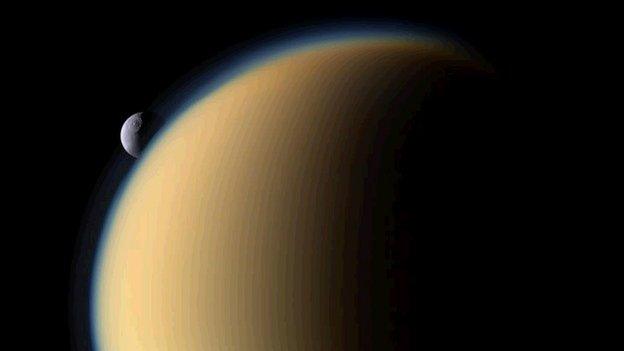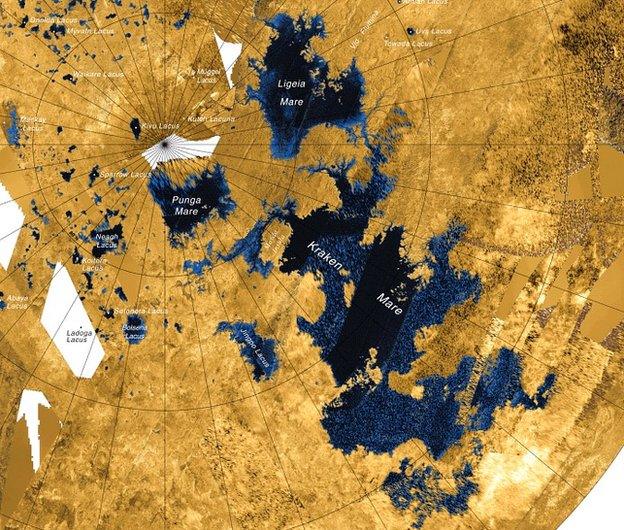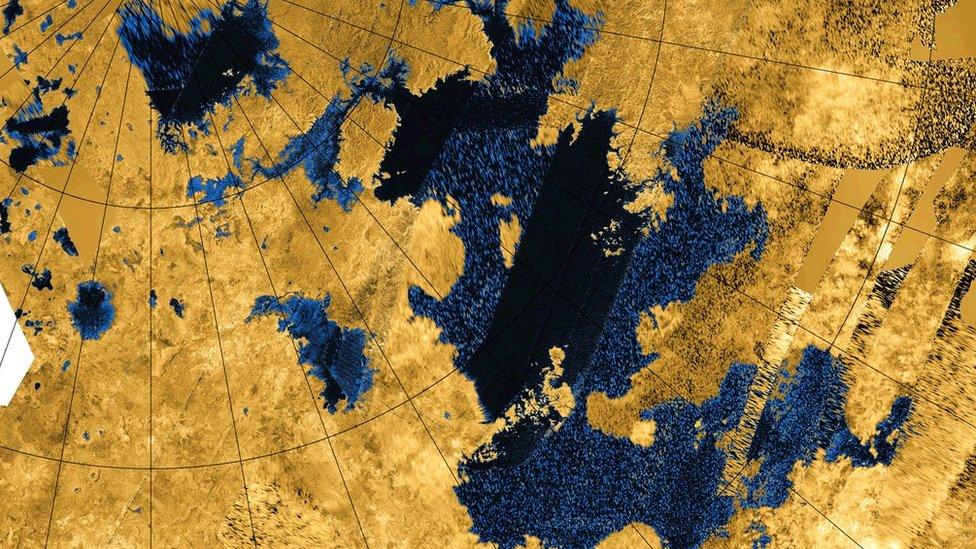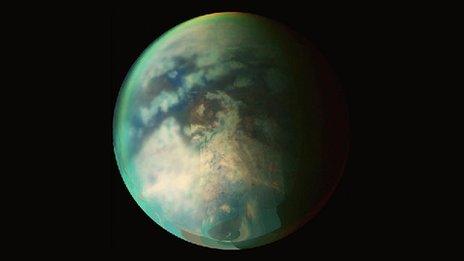'Waves' detected on Titan moon’s lakes
- Published

Titan, seen here with Tethys in the background, is shrouded in an orange haze of organic chemicals
Scientists believe they have detected the first liquid waves on the surface of another world.
The signature of isolated ripples was observed in a sea called Punga Mare on the surface of Saturn's moon Titan.
However, these seas are filled not with water, but with hydrocarbons like methane and ethane.
These exist in their liquid state on Titan, where the surface temperature averages about -180C.
Planetary scientist Jason Barnes discussed details of his findings at the 45th Lunar and Planetary Science Conference (LPSC), external in Texas this week.
Titan is a strange, looking-glass version of Earth with a substantial atmosphere and a seasonal cycle. Wind and rain shape the surface to form river channels, seas, dunes and shorelines.
But much of what's familiar is also turned sideways: the moon's mountains and dune fields are made of ice, rather than rock or sand, and liquid hydrocarbons take up many of the roles played by water on Earth.
The vast majority of Titan's lakes and seas are concentrated around the north polar region. Just one of these bodies of liquid - Ligeia Mare - is estimated to contain about 9,000 cubic km of mostly liquid methane, equating to about 40 times the proven reserves of oil and gas on Earth.
An image of Titan's north pole taken by the Cassini probe during a flyby in July 2012 shows sunlight being reflected from surface liquid in much the same way as a mirror re-directs light. This phenomenon is known as a specular reflection.
Dr Barnes, from the University of Idaho in Moscow, US, used a mathematical model to investigate whether the features in the image were compatible with waves.
"We think we've found the first waves outside the Earth," he told the meeting.
"What we're seeing seems to be consistent with waves at just a few locations in Punga Mare [with a slope] of six degrees."
He said other possibilities, such as a wet mudflat, could not be ruled out.
But assuming these were indeed waves, Dr Barnes calculates that a wind speed of around 0.75 m/s is required to produce ripples with the requisite slope of six degrees.
That points to the waves being just 2cm high. "Don't make your surfing vacation reservations for Titan just yet," Dr Barnes quipped.
However, Titan appears to be on the brink of major seasonal changes, which present important opportunities for scientists to gain a better understanding of this complex and endlessly surprising world.
"The expectation is that any day now, the winds will start getting strong enough as we move into northern summer, and the waves will start picking up," Ralph Lorenz, from the Johns Hopkins Applied Physics Laboratory (JHUAPL) in Maryland, told BBC News.
"You can also get a phenomenon known as wind set-up, where wind over a body of water will cause the liquid to pile up, potentially causing a storm surge."
He added: "A metre of storm surge, a metre of tides, is certainly within the realms of possibility for Titan. Whether we can see that [with Cassini] is another matter."
Dr Lorenz said he was hopeful that sea level rise of a metre in height could cause shorelines to migrate and that this could be picked up from orbit.
Titan operates on a 30-year seasonal cycle, with the northern region currently approaching summer solstice, which it will mark in 2017.

Titan's lakes and seas are concentrated at the saturnian moon's north pole
Computer models of Titan's weather suggest that the northern summer is approaching the rainy season, in which liquid hydrocarbons are "pumped" from the south pole to the north by the climate cycle.
Sometime soon, scientists expect, clouds will start to gather at the north pole and it should start to rain.
"We have a long-term picture of liquid levels rising in the north and declining in the south. But that's against the backdrop of seeing what we think are evaporite deposits around the northern seas and lakes," Dr Lorenz explained.
These evaporite regions are Titan's equivalent to salt flats on Earth where bodies of water evaporate, leaving behind minerals that had previously been dissolved in the water.
"That suggests that while the sea level is rising in the current epoch, at some time in the past, the liquid level was much higher than it is today. We've now mapped most of the surface and there aren't large areas where you could hide another sea," he explained.
The amount of moisture in the climate system might fluctuate because methane is continuously destroyed in the atmosphere by sunlight. But scientists think it could also be re-supplied via volcanic belches from beneath the moon's surface.
'Tidal roar'
In his own presentation at the LPSC, Dr Lorenz focused on a narrow "throat" feature that separates the two main basins of Titan's largest sea, Kraken Mare.
Dubbing it the "Throat of Kraken", he said it was similar in size to the Straits of Gibraltar and might generate fast-moving tidal currents through the narrow channel.
Dr Lorenz pointed out that on Earth, such circumstances can produce whirlpools, and in the case of the Corryvreckan off the coast of Scotland, a tidal maelstrom generates a roar that can be heard 16km away. Whether such phenomena existed at this location on Titan was pure speculation, he said.
Dr Lorenz explained: "It's really getting quite exciting, because we're starting to get a literal big picture, in the sense that the radar coverage [of Titan's surface] is close to complete. But because we're moving into northern summer, there's better lighting, which means the camera and the near-infrared spectrometer on Cassini are also able to map the northern seas."
"Everything is really starting to come together, and the seas and lakes are very much becoming the central topic in Titan science."
Paul.Rincon-INTERNET@bbc.co.uk and follow me on Twitter, external
- Published13 December 2013

- Published1 October 2013

- Published22 March 2012
